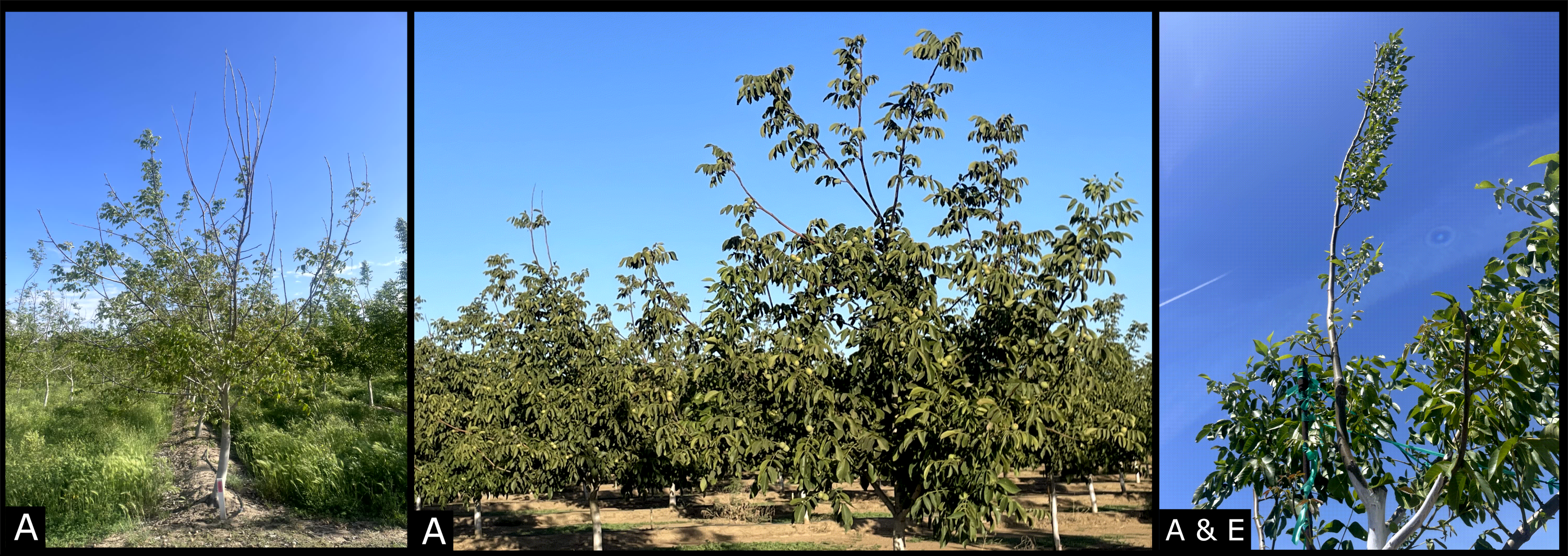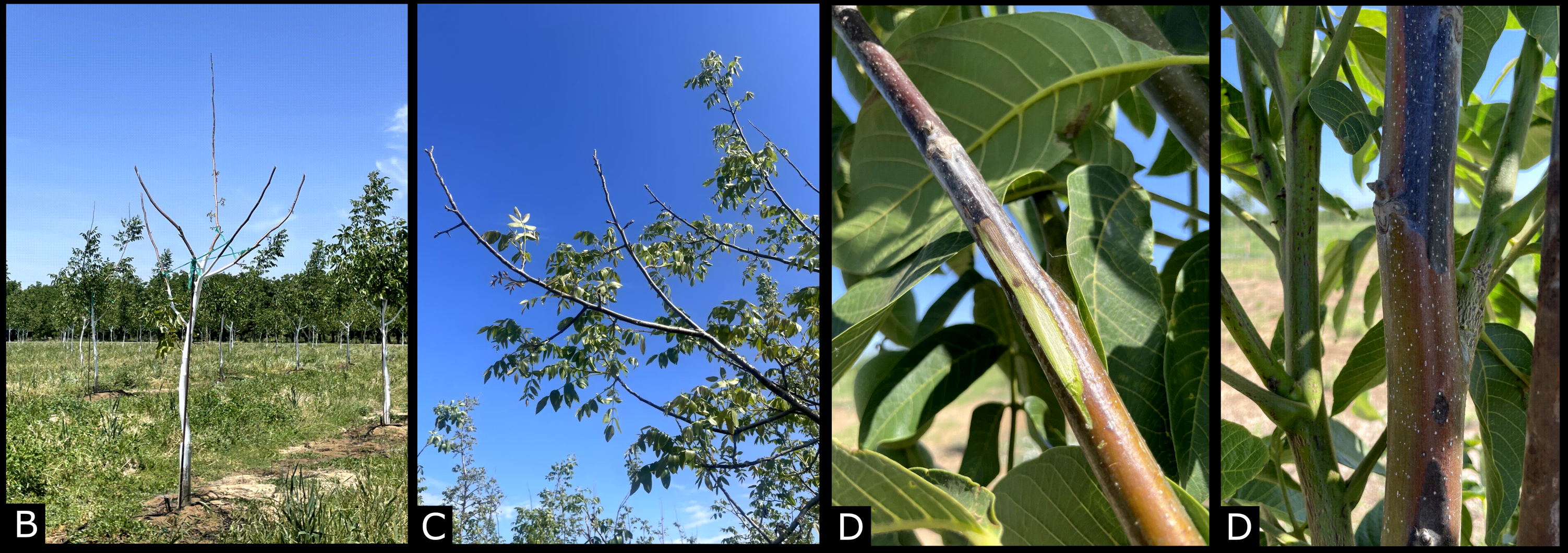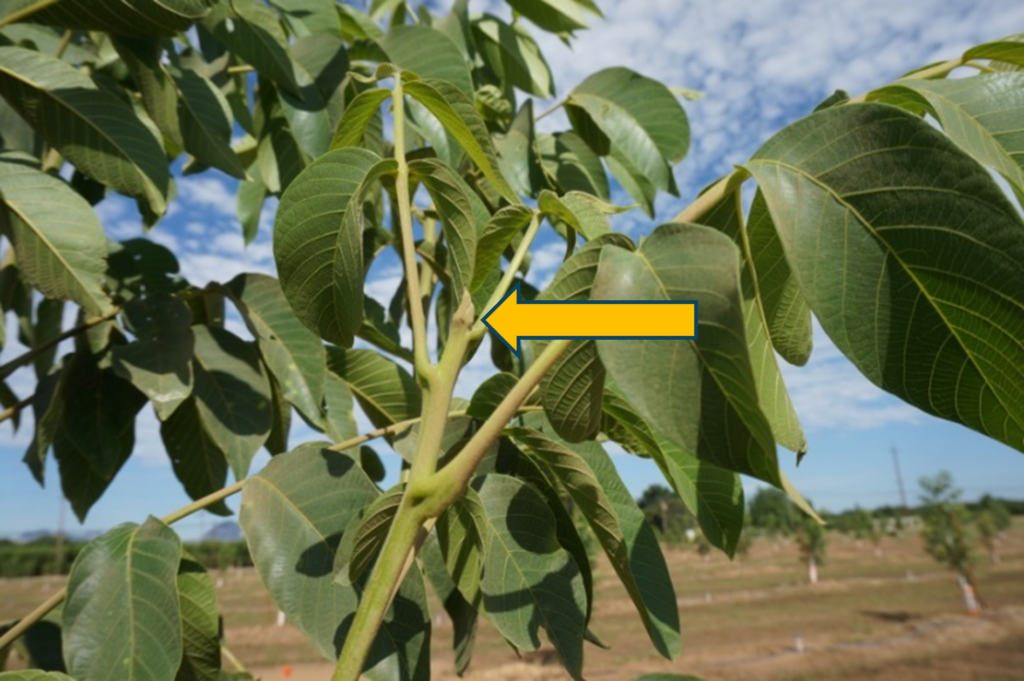Clarissa Reyes, Orchards Advisor, Sutter-Yuba, Butte, and Placer counties
Luke Milliron, UCCE Farm Advisor Butte, Glenn, and Tehama Counties
Autumn freeze damage in walnuts can occur when trees experience freezing temperatures prior to going into dormancy. In recent history, Sacramento Valley growers experienced this most severely in 2018, and since then, many have implemented management practices to prevent widespread damage.
Symptoms of freeze damage can include:
- Late leaf-out in affected limbs
- Weak or dead terminal budwood and smaller upper limbs (mild/moderate damage)
- Major limb death, mainly in the upper and exposed portions of the tree, and/or apparent whole tree death (severe damage)
- Darkened or orange-tinted wood, with gray/black streaking in the cambium underneath
- Sunburn on damaged limbs, usually on south- and west-facing sides
This past spring (2024), growers in Sutter, Yuba, Yolo, and Tehama counties reported symptoms of freeze damage, likely from an early autumn freeze that occurred near Halloween. If you noticed any of these symptoms in your orchards this past spring or are aware of cold pockets in certain areas/fields, consider the following steps to prevent another year of freeze damage.



Preventative management:
Tree development:
1. For young trees, it’s best to cut off N applications by mid-August to prevent tender new growth that is most vulnerable to freeze damage. Also, withhold irrigation starting in early to mid-September to set a terminal bud on the trunk (Figure 2). After the terminal bud has set, resume irrigation to avoid tree stress and defoliation, without the fear of pushing tender new growth.

Figure 2. Withhold irrigation until a terminal vegetative bud sets on trunk (Photo: Janine Hasey)
2. For mature trees, cut off nitrogen (N) applications by the beginning of September. Terminal buds may set as a positive side effect of the water cutoff done ahead of harvest to avoid shaker injury.
Increase soil heat storage:
3. Maintain short groundcover during autumn frost season, beginning mid-October. Keeping groundcovers cut to 2 inches or less during frost season allows sunlight to reach the soil surface, increasing soil heat storage for a warmer orchard through the night. Recently cultivated soil has many air spaces, low heat storage capacity, and low heat conductivity resulting in colder minimum temperatures. The ground surface must be moist for bare ground to be the warmest (see steps 4 and 5).
4. Trees that remain water-stressed after the heat of summer are the most vulnerable to autumn and winter freeze damage. If there has not been adequate rainfall by mid-October for young orchards, or immediately after harvest for mature orchards, begin irrigating to refill the soil profile.
5. Water-filled spaces in the soil conduct and store more heat than empty air spaces. Once the soil profile has been refilled, the top several inches of soil are the most important for freeze mitigation and should be kept at field capacity (not saturated/ponding) if possible. Either a dry surface crust on one extreme or a frozen sheet of ponded water on the other extreme will both hinder the re-radiation of stored daytime heat during the night.
6. Continue to actively monitor soil moisture and freeze predictions in November and December (until trees are acclimated to frost – see note below). Since freeze events are variable depending on location, monitoring each block remotely with a freeze alarm makes good sense. If a freeze is predicted and the soil is dry, irrigate to wet the soil 2 to 3 days before a freeze event to fill the air spaces so the soil will store more heat. Light irrigation to moisten a dry soil surface the morning before a freeze will help obtain the greatest heat storage for re-radiation at night (as long as there is no standing water during the freeze event).
Active irrigation during freeze event:
7. Some growers with the ability to actively irrigate during sudden autumn freeze events have reported success in preventing damage. With active irrigation, heat is given off as water converts from liquid to ice. This occurs during the coldest hours of the early morning of the freeze event and is the reason higher flow rates are needed to more successfully manage frost events.
-
- We know from work in almonds that active frost protection with solid set irrigation can achieve as much as 4 degrees protection if your system can run 40 gpm/ac.
- With micro-sprinkler irrigation, 1-2 degrees of warming can be achieved with at least 30 gpm/ac. 25 gpm/ac has been shown to be enough to keep sprinkler heads from freezing.
Painting:
8. In addition to water management, painting young trunks and shoots white can minimize damage if applied as soon as possible after a freeze. Research by UC Walnut Specialist Bruce Lampinen has shown painting after leaf fall with white interior latex paint diluted 50% with water minimizes damage to shoots and buds, especially on the south-west side of the tree. The paint moderates large day-to-night temperature fluctuations after sunny winter days.
Treatment:
If you suspect freeze damage occurred, cut into the branches shortly after a freeze event and check the tissue for drying or browning. Swift action in the week after a freeze event can significantly decrease damage. If you don’t paint early, painting trees after a freeze can still help decrease severe damage. Wilbur Reil, Farm Advisor Emeritus, found that when trees were painted a week after a freeze event 18% showed damage, compared with 46% damaged in the unpainted trees. Painting any parts that may be damaged should improve recovery and protect against winter sunburn of affected tissue.
New growth typically occurs below the damaged/dead locations. Dead wood should be pruned out later in the season (mid-summer), after the tree has fully leafed out, to reduce potential colonization sites by Bot or Phomopsis. In young trees with significant freeze damage, remaining limbs or new limbs may have to be trained as new scaffolds.
Potential causes:
In “normal” years, the combination of short days, gradually dropping fall temperatures, and rainfall pattern allows trees to go into dormancy in a stepwise pattern (2021 and 2022 in Figure 3 below). In years where we’ve received more reports of autumn freeze damage, there have been large differences in daily high and low temperature (2020), and sudden drops to freezing temperatures prior to trees reaching full dormancy (2020 and 2023).

Figure 3. High (pink) and low (blue) temperatures from the Verona CIMIS station in 2020-2023. Arrows indicate drastic drops from high daytime temps to freezing (horizontal blue line) in 2020 and 2023, whereas in 2021 and 2022 the differences between high and low temps are smaller, and low temps reach freezing more gradually.
As temperatures drop into the low 30s °F and days shorten, carbohydrates move from leaves to wood and starch converts to soluble sugars. Slow cooling is needed to promote starch degradation into sugars, which act as “antifreeze” to protect cells from freezing, as does adequate soil moisture, which keeps cells hydrated. When temperatures suddenly and prematurely drop below 32°F before the acclimation process is completed, carbohydrate movement is likely disrupted and trees are susceptible to freeze damage.
Unfortunately, we do not know how many frost/mild freeze events are required to sufficiently acclimate trees in autumn. So far, growers that were previously hit hard by fall freeze events have reported success in avoiding subsequent freeze damage by having frost alarms ready and turned on by October 15, completely rehydrating trees after harvest, and actively irrigating during freeze events. Eventually, once mature healthy trees are fully dormant, they can tolerate temperatures to the low 20s °F or below.


Leave a Reply